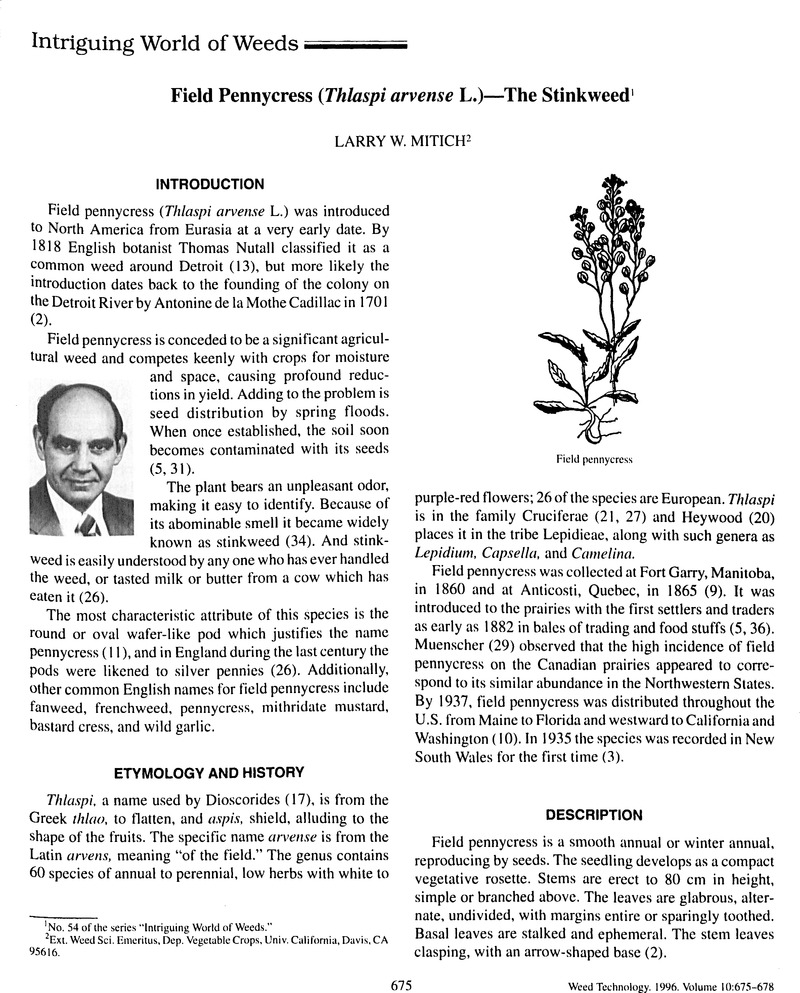Crossref Citations
This article has been cited by the following publications. This list is generated based on data provided by Crossref.
VAUGHN, STEVEN F.
ISBELL, TERRY A.
WEISLEDER, DAVID
and
BERHOW, MARK A.
2005.
BIOFUMIGANT COMPOUNDS RELEASED BY FIELD PENNYCRESS (Thlaspi arvense) SEEDMEAL.
Journal of Chemical Ecology,
Vol. 31,
Issue. 1,
p.
167.
Zhou, Ning
Robinson, Stephen J.
Huebert, Terry
Bate, Nicholas J.
and
Parkin, Isobel A. P.
2007.
Comparative genome organization reveals a single copy of CBF in the freezing tolerant crucifer Thlaspi arvense.
Plant Molecular Biology,
Vol. 65,
Issue. 5,
p.
693.
Dorn, Kevin M.
Fankhauser, Johnathon D.
Wyse, Donald L.
and
Marks, M. David
2013.
De novo assembly of the pennycress (Thlaspi arvense) transcriptome provides tools for the development of a winter cover crop and biodiesel feedstock.
The Plant Journal,
Vol. 75,
Issue. 6,
p.
1028.
Sedbrook, John C.
Phippen, Winthrop B.
and
Marks, M. David
2014.
New approaches to facilitate rapid domestication of a wild plant to an oilseed crop: Example pennycress (Thlaspi arvense L.).
Plant Science,
Vol. 227,
Issue. ,
p.
122.
Van Gerpen, J.H.
and
He, B.B.
2014.
Advances in Biorefineries.
p.
441.
Groeneveld, Janna H.
and
Klein, Alexandra‐Maria
2014.
Pollination of two oil‐producing plant species: Camelina (Camelina sativa L. Crantz) and pennycress (Thlaspi arvense L.) double‐cropping in Germany.
GCB Bioenergy,
Vol. 6,
Issue. 3,
p.
242.
Groeneveld, Janna H.
and
Klein, Alexandra-Maria
2015.
Pennycress-corn double-cropping increases ground beetle diversity.
Biomass and Bioenergy,
Vol. 77,
Issue. ,
p.
16.
Groeneveld, Janna H.
Lührs, Hans P.
and
Klein, Alexandra-Maria
2015.
Pennycress double-cropping does not negatively impact spider diversity.
Agricultural and Forest Entomology,
Vol. 17,
Issue. 3,
p.
247.
Wood, Jennifer L.
Tang, Caixian
and
Franks, Ashley E.
2016.
Microbial associated plant growth and heavy metal accumulation to improve phytoextraction of contaminated soils.
Soil Biology and Biochemistry,
Vol. 103,
Issue. ,
p.
131.
Evangelista, Roque L.
Cermak, Steven C.
Hojilla-Evangelista, Milagros P.
Moser, Bryan R.
and
Isbell, Terry A.
2017.
Surfactants in Tribology, Volume 5.
p.
369.
McGinn, Michaela
Phippen, Winthrop B.
Chopra, Ratan
Bansal, Sunil
Jarvis, Brice A.
Phippen, Mary E.
Dorn, Kevin M.
Esfahanian, Maliheh
Nazarenus, Tara J.
Cahoon, Edgar B.
Durrett, Timothy P.
Marks, M. David
and
Sedbrook, John C.
2019.
Molecular tools enabling pennycress (Thlaspi arvense) as a model plant and oilseed cash cover crop.
Plant Biotechnology Journal,
Vol. 17,
Issue. 4,
p.
776.
Bishop, Logan
and
Nelson, Kelly A.
2019.
Field Pennycress Seeding Date and Corn Herbicide Management Effects on Corn, Pennycress, and Soybean Production.
Agronomy Journal,
Vol. 111,
Issue. 1,
p.
257.
Ott, Matthew A.
Eberle, Carrie A.
Thom, Matt D.
Archer, David W.
Forcella, Frank
Gesch, Russell W.
and
Wyse, Donald L.
2019.
Economics and Agronomics of Relay‐Cropping Pennycress and Camelina with Soybean in Minnesota.
Agronomy Journal,
Vol. 111,
Issue. 3,
p.
1281.
Geng, Yupeng
Chang, Na
Zhao, Yuewan
Qin, Xiaoying
Lu, Shugang
Crabbe, M. James C.
Guan, Yabin
and
Zhang, Ticao
2020.
Increased epigenetic diversity and transient epigenetic memory in response to salinity stress in Thlaspi arvense.
Ecology and Evolution,
Vol. 10,
Issue. 20,
p.
11622.
García Navarrete, Tatiana
Arias, Cintia
Mukundi, Eric
Alonso, Ana Paula
Grotewold, Erich
and
Hufford, M B
2022.
Natural variation and improved genome annotation of the emerging biofuel crop field pennycress (Thlaspi arvense).
G3 Genes|Genomes|Genetics,
Phippen, Winthrop B.
Rhykerd, Rob
Sedbrook, John C.
Handel, Cristine
and
Csonka, Steve
2022.
From Farm to Flight: CoverCress as a Low Carbon Intensity Cash Cover Crop for Sustainable Aviation Fuel Production. A Review of Progress Towards Commercialization.
Frontiers in Energy Research,
Vol. 10,
Issue. ,
Luo, Peishan
and
Reineccius, Gary
2022.
Identification of volatile compounds contributing to pennycress aroma.
Flavour and Fragrance Journal,
Vol. 37,
Issue. 6,
p.
375.
Kang, Minjeong
Lee, Keunsub
and
Wang, Kan
2022.
Protoplast Technology.
Vol. 2464,
Issue. ,
p.
153.
Li, Gengyun
Zhao, Yuewan
Liu, Fei
Shi, Minnuo
Guan, Yabin
Zhang, Ticao
Zhao, Fangqing
Qiao, Qin
and
Geng, Yupeng
2022.
Transcriptional memory of gene expression across generations participates in transgenerational plasticity of field pennycress in response to cadmium stress.
Frontiers in Plant Science,
Vol. 13,
Issue. ,





